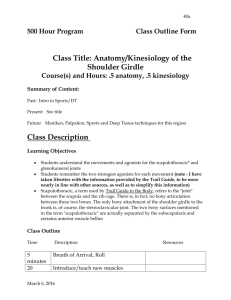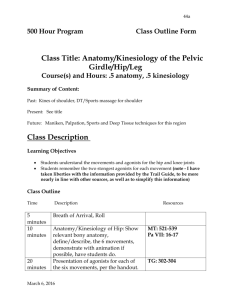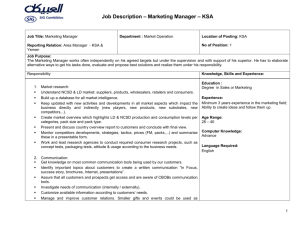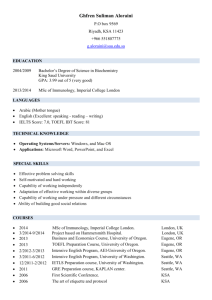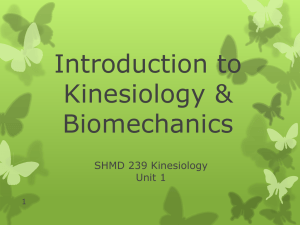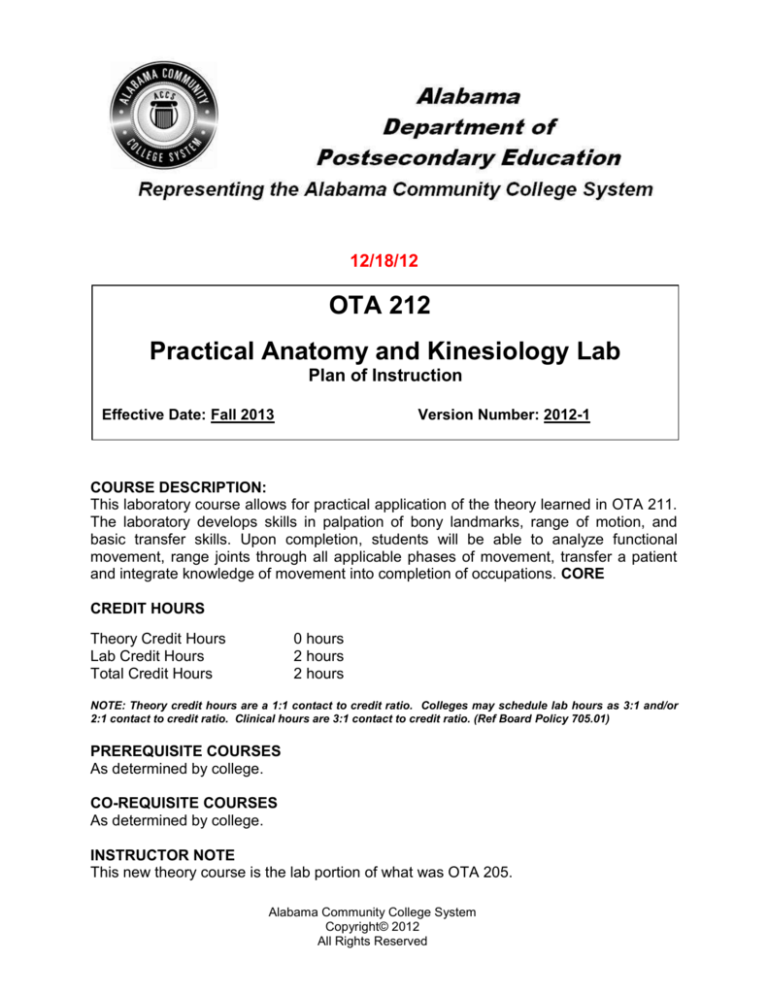
12/18/12
OTA 212
Practical Anatomy and Kinesiology Lab
Plan of Instruction
Effective Date: Fall 2013
Version Number: 2012-1
COURSE DESCRIPTION:
This laboratory course allows for practical application of the theory learned in OTA 211.
The laboratory develops skills in palpation of bony landmarks, range of motion, and
basic transfer skills. Upon completion, students will be able to analyze functional
movement, range joints through all applicable phases of movement, transfer a patient
and integrate knowledge of movement into completion of occupations. CORE
CREDIT HOURS
Theory Credit Hours
Lab Credit Hours
Total Credit Hours
0 hours
2 hours
2 hours
NOTE: Theory credit hours are a 1:1 contact to credit ratio. Colleges may schedule lab hours as 3:1 and/or
2:1 contact to credit ratio. Clinical hours are 3:1 contact to credit ratio. (Ref Board Policy 705.01)
PREREQUISITE COURSES
As determined by college.
CO-REQUISITE COURSES
As determined by college.
INSTRUCTOR NOTE
This new theory course is the lab portion of what was OTA 205.
Alabama Community College System
Copyright© 2012
All Rights Reserved
Practical Anatomy and Kinesiology Lab
OTA 212
PROFESSIONAL COMPETENCIES
Describe the basic principles of kinesiology, utilizing principles of mechanics,
musculoskeletal anatomy and the nervous system and how each relates to
human movement.
Articulate the complex interactions of multiple body systems causing functional
movement patterns in an individual’s daily life.
Articulate the impact that context and environment have on functional movement.
Define and describe the performance skills and client factors that impact
movement.
Correlate how posture, positioning and stability are related to occupational
performance.
Explain the function of the lower extremity for engagement in daily occupations.
Describe the relationship of the shoulder complex to the overall function of the
upper extremity.
Explain the role of the shoulder complex in performing activities of daily living
(ADL).
Describe the relationship of the shoulder complex to the overall function of the
upper extremity.
Explain the role of the elbow complex in performing activities of daily living (ADL).
Describe the relationship of the shoulder complex to the overall function of the
upper extremity.
Explain the role of the elbow complex in performing activities of daily living (ADL).
INSTRUCTIONAL GOALS
Cognitive – Comprehend principles and concepts related to practical anatomy
and kinesiology.
Psychomotor – Apply principles of practical anatomy and kinesiology.
Affective – Value the importance of adhering to policy and procedures related to
practical anatomy and kinesiology.
STUDENT OBJECTIVES
Condition Statement: Unless otherwise indicated, evaluation of student’s attainment
of objectives is based on knowledge gained from this course. Specifications may be in
the form of, but not limited to, cognitive skills diagnostic instruments, manufacturer’s
specifications, technical orders, regulations, national and state codes, certification
agencies, locally developed lab/clinical assignments, or any combination of
specifications.
ACCS Copyright© 2012
All Rights Reserved
2
Practical Anatomy and Kinesiology Lab
OTA 212
STUDENT LEARNING OUTCOMES
MODULE A – KINESIOLOGY BASICS
MODULE DESCRIPTION – The purpose of this module is to introduce the students to the
basic components of the human body that produces movement. Included will be an
explanation of the body systems and body functions that influence movement.
PROFESSIONAL COMPETENCIES
PERFORMANCE OBJECTIVES
KSA
A1.0 Describe the basic principles of A1.1 Demonstrate movements for all
2
kinesiology, utilizing principles
joints of the body.
of mechanics, musculoskeletal
anatomy and the nervous
system and how each relates
to human movement.
LEARNING OBJECTIVES
KSA
A1.1.1 Define descriptive terminology associated with anatomy, physiology and
the nervous system.
A1.1.2 Identify mechanical principles that relate directly to the human body.
A1.1.3 Discuss the definitions and descriptions of movement and the analysis of
these forces influencing movements.
A1.1.4 Name and discuss anatomical and functional descriptions of the central
and peripheral nervous systems as they affect muscle movement.
MODULE A OUTLINE:
Kinesiology and Occupational Therapy
o Application of kinesiology in occupational therapy through history
o Engagement in human occupation
o Occupational therapy Practice Framework
1
1
3
2
MODULE B – STRUCTURES AND FUNCTION THAT INFLUENCE MOVEMENT
MODULE DESCRIPTION – This module will consider the inter-related systems of the
body that cause us to move. It will include study of the anatomical structures and
functions of the body and how they impact movement. The focus will include the nervous,
skeletal and muscular systems.
PROFESSIONAL COMPETENCIES
PERFORMANCE OBJECTIVES
KSA
B1.0 Articulate the complex
B1.1 Demonstrate and name all
2
interactions of multiple body
movements in each plane.
systems causing functional
movement patterns in an
B1.1 Identify bony landmarks on
1
individual’s daily life.
skeleton.
B1.1
ACCS Copyright© 2012
All Rights Reserved
Identify components of and
diagram the brachial plexus.
2
3
Practical Anatomy and Kinesiology Lab
OTA 212
LEARNING OBJECTIVES
B1.1.1 Identify and describe types of joints, joint structure and the various
movements that occur at each joint.
B1.1.2 Identify the types of bones and structures of the skeletal system as well
as the function of the skeletal system and landmarks of each bone.
B.1.1.3 Discuss the role of muscles.
B.1.1.4 Name and discuss anatomical and functional descriptions of the central
nervous system and peripheral nervous system and how they affect
muscle movement.
MODULE B OUTLINE:
Body functions
o Nervous system functions
o Cardiovascular and respiratory system functions
o Muscular system functions
o Skeletal functions
Body Structures
o Nervous system functions
o Cardiovascular and respiratory system functions
o Muscular system functions
o Skeletal functions
KSA
2
1
1
2
MODULE C – MOVEMENT DEMANDS AND CONTEXTUAL AND ENVIRONMENTAL
FACTORS INFLUENCING MOVEMENT
MODULE DESCRIPTION – The purpose of this module is to explore the significance of
context (cultural, personal, temporal, and virtual) and environment (physical and social) on
the ability of the client to perform his or her daily occupations. Students will explore the
Occupational Therapy Practice Framework: Domain and Process and discover the
specific performance skills and client factors that may impair or inhibit participation in
occupations.
PROFESSIONAL COMPETENCIES
PERFORMANCE OBJECTIVES
KSA
C1.0 Articulate the impact that
C1.1 Demonstrate various movements
3
context and environment have
within different environments.
on functional movement
C2.0 Define and describe the
C2.1 Role-play clients affected by
2
performance skills and client
disease or dysfunction.
factors that impact movement.
LEARNING OBJECTIVES
KSA
C1.1.1 Discuss the relationship of four contextual factors and the impact each
area has on another.
C1.1.2 Describe how changing or modifying one contextual or environmental
factor can enhance or interfere with occupational performance.
3
ACCS Copyright© 2012
All Rights Reserved
4
3
Practical Anatomy and Kinesiology Lab
OTA 212
C2.1.1 Identify typical and atypical motor behavior as demonstrated by the client.
C2.1.2 Recognize the importance of posture and anticipatory postural
movements to facilitate human movement
C2.1.3 Find neuromusculoskeletal and movement related functions as listed in
the Occupational Therapy Practice Framework: Domain and Process.
2
2
2
MODULE C OUTLINE:
Contextual factors
o Cultural
o Personal
o Temporal
o Virtual
Environmental Factors
o Physical environment
o Social environment
Movement Demands
o Motor behavior
o Typical and atypical movement patterns
o Posture
MODULE D – FUNCTION AND MOVEMENT OF THE NECK AND TRUNK
MODULE DESCRIPTION – This module will focus on the structure and function of the
trunk and head. Students will identify spinal curves, joint motions and movement
characteristics and how they are related to posture, movement and function.
PROFESSIONAL COMPETENCIES
PERFORMANCE OBJECTIVES
KSA
D1.0 Correlate how posture,
D1.1 Identify and demonstrate the role
3
positioning and stability are
and function of the muscles of the
related to occupational
neck and trunk.
performance.
LEARNING OBJECTIVES
KSA
D1.1.1 Identify muscle attachments, actions and nerve innervations of the neck
and trunk.
D1.1.2 Identify skeletal structures of the neck and trunk, including the
classification of vertebrae.
D1.1.3 Discuss medical conditions affecting the neck and trunk.
D1.1.4 Describe positioning of the pelvis, trunk and neck for ideal posture in a
wheelchair.
MODULE C OUTLINE:
Body Functions of the Neck and Trunk
o Motions of neck and trunk
o Observation of vertebral curves, trunk and pelvic girdle position and sitting
balance
o Common problems with trunk and neck
Body Structures of the Trunk and Neck
2
ACCS Copyright© 2012
All Rights Reserved
5
1
2
2
Practical Anatomy and Kinesiology Lab
OTA 212
o Structure of spine and rib cage
o Structure of pelvic girdle
o Muscles of trunk and neck
MODULE E – FUNCTION AND MOVEMENT OF THE LOWER EXTREMITIES
MODULE DESCRIPTION – The purpose of this module is to demonstrate how body
functions and structures are related to function and movement of the lower extremity. It
will focus on the many functions of the lower extremity that assists the client in engaging in
occupation. Also included in the discussion is the contribution of the lower extremity in
balance and equilibrium.
PROFESSIONAL COMPETENCIES
PERFORMANCE OBJECTIVES
KSA
E1.0 Explain the function of the
E1.1 Identify and demonstrate the role
3
lower extremity for engagement
and function of the muscles of the
in daily occupations.
lower extremities.
LEARNING OBJECTIVES
E1.1.1 Identify muscle attachments, actions and nerve innervations of the lower
extremities.
E1.1.2 Label the bony landmarks and joint components of the lower extremities.
E1.1.3 Discuss medical conditions affecting the lower extremities.
E1.1.4 Describe how the lower extremities assist in maintaining sitting and
standing balance.
E1.1.5 Recognize, through observation, and report abnormal gait patterns that
may cause safety issues and injury.
MODULE E OUTLINE:
Functions of the Lower Extremity
o Role of OT and the lower extremity
o Motions of the lower extremity
o Visual observation of gait
o Common problems of the lower extremity
Structures of the Lower Extremity
o Structures of the hip
o Structures of the knee
o Structures of the ankle
KSA
2
1
2
2
3
MODULE F – FUNCTION AND MOVEMENT OF THE SHOULDER COMPLEX
MODULE DESCRIPTION – This module will provide information of how body functions
and structure are related to the shoulder complex and how occupational therapy
intervention can address impairments of the shoulder.
PROFESSIONAL COMPETENCIES
PERFORMANCE OBJECTIVES
KSA
F1.0 Describe the relationship of the F1.1 Identify and demonstrate the role
3
shoulder complex to the overall
and function of the muscles of the
function of the upper extremity.
shoulder complex.
ACCS Copyright© 2012
All Rights Reserved
6
Practical Anatomy and Kinesiology Lab
F 2.0 Explain the role of the shoulder F2.1
complex in performing activities
of daily living (ADL).
OTA 212
Role play assigned ADL.
LEARNING OBJECTIVES
F1.1.1 Identify muscle attachments, actions and nerve innervations of the
shoulder complex
F1.1.2 Label the bony landmarks and joint components of the shoulder complex.
F1.1.3 Discuss medical conditions affecting the shoulder complex
F 2.1.1 Identify range of motion of shoulder complex necessary for specific ADL.
2
KSA
2
1
2
2
MODULE C OUTLINE:
Body Functions of the Shoulder Complex
o Motions of the shoulder girdle and shoulder joint
o Common problems with the shoulder girdle and shoulder joint
Body Structures of the shoulder Complex
o Muscle and muscle actions
o Nerves
o Spinal Cord Levels
MODULE G – FUNCTION AND MOVEMENT OF THE ELBOW COMPLEX
MODULE DESCRIPTION – The purpose of this module is to demonstrate occupational
therapy intervention as related to the structure and function of the elbow complex.
Discussion will also focus on the role of the elbow complex in performing activities of daily
living.
PROFESSIONAL COMPETENCIES
PERFORMANCE OBJECTIVES
KSA
G1.0 Describe the relationship of the G1.1 Identify and demonstrate the role
3
shoulder complex to the overall
and function of the muscles of the
function of the upper extremity
elbow complex.
G 2.0 Explain the role of the elbow
G 2.1 Role play assigned ADL.
complex in performing activities
of daily living (ADL).
LEARNING OBJECTIVES
2
KSA
G 1.1.1 Identify muscle attachments, actions and nerve innervations of the
elbow complex.
G 1.1.2 Label the bony landmarks and joint components of the elbow complex.
G 1.1.3 Discuss medical conditions affecting the elbow complex.
G 2.1.1 Identify range of motion of elbow joint and radioulnar joints necessary for
specific ADL.
MODULE F OUTLINE:
Body Functions of the Elbow Complex
o Motions of the elbow joint and radioulnar joints
2
ACCS Copyright© 2012
All Rights Reserved
7
1
2
2
Practical Anatomy and Kinesiology Lab
OTA 212
o Effects of limited range of motion on performance of ADL
o Common problems with the elbow complex
Body Structures of the shoulder Complex
o Muscle and muscle actions
o Nerves
o Spinal Cord Levels
MODULE H – FUNCTION AND MOVEMENT OF THE WRIST AND HAND
MODULE DESCRIPTION – The purpose of this module is to demonstrate occupational
therapy intervention as related to the structure and function of the wrist and hand.
Discussion will also focus on the role of the wrist and hand in performing activities of daily
living.
PROFESSIONAL COMPETENCIES
PERFORMANCE OBJECTIVES
KSA
H 1.0 Describe the relationship of the H1.1 Identify and demonstrate the role
3
shoulder complex to the overall
and function of the muscles of the
function of the upper extremity
wrist and hand.
H 2.0 Explain the role of the elbow
H 2.1 Role play assigned ADL.
complex in performing activities
of daily living (ADL).
LEARNING OBJECTIVES
2
KSA
H 1.1.1 Identify muscle attachments, actions and nerve innervations of the wrist
and hand
H 1.1.2 Label the bony landmarks and joint components of the wrist and hand.
H 1.1.3 Discuss medical conditions affecting the elbow complex
H 2.1.1 Identify range of motion of wrist and hand joints necessary for specific
ADL.
MODULE H OUTLINE:
Body Functions of the Wrist and Hand
o Motions of the wrist and hand joints
o Effects of limited range of motion on performance of ADL
o Common problems with the wrist and hand joints
Body Structures of the wrist and hand joints
o Muscle and muscle actions
o Intrinsic and Extrinsic Muscles
o Nerves
o Spinal Cord Levels
2
ACCS Copyright© 2012
All Rights Reserved
8
1
2
2
Practical Anatomy and Kinesiology Lab
OTA 212
LEARNING OUTCOMES TABLE OF SPECIFICATIONS
The table below identifies the percentage of learning objectives for each module.
Instructors should develop sufficient numbers of test items at the appropriate
level of evaluation.
Limited
Knowledge and
Proficiency
KSA
Module A
Module B
Module C
Module D
Module E
Module F
Module G
Module H
1
50%
50%
25%
20%
25%
25%
25%
Moderate
Knowledge
and
Proficiency
2
25%
50%
60%
75%
60%
75%
75%
75%
Advanced
Knowledge
and
Proficiency
3
25%
Superior
Knowledge
and
Proficiency
4
40%
20%
The KSA is NOT determined by the verb used in the learning objective, but rather in the context in which
the verb is used and the depth of knowledge and skills required.
Example: Three KSA levels using the same verb (describe):
KSA 1 – Describe three characteristics of metamorphic rocks. (simple recall)
KSA 2 – Describe the difference between metamorphic and igneous rocks. (requires cognitive
processing to determine the differences in the two rock types)
KSA 3 – Describe a model that you might use to represent the relationships that exist within the rock
cycle. (requires deep understanding of rock cycle and a determination of how best to represent it)
ACCS Copyright© 2012
All Rights Reserved
9
Practical Anatomy and Kinesiology Lab
Indicator Key Terms
1
Limited
Knowledge
and
Proficiency
2
Moderate
Knowledge
and
Proficiency
3
Advanced
Knowledge
and
Proficiency
4
Superior
Knowledge
and
Proficiency
A
Affective
Objective
ACCS Copyright© 2012
All Rights Reserved
OTA 212
Learner’s Knowledge, Skills and Abilities
Description
Recognize basic information about the subject including terms
and nomenclature.
Students must demonstrate ability to recall information such as
facts, terminology or rules related to information previously
taught.
Performs simple parts of the competency. Student requires
close supervision when performing the competency.
Distinguish relationships between general principles and facts.
Adopts prescribed methodologies and concepts.
Students must demonstrate understanding of multiple facts
and principles and their relationships, and differentiate between
elements of information. Students state ideal sequence for
performing task.
Performs most parts of the competency with instructor
assistance as appropriate.
Examines conditions, findings, or other relevant data to select an
appropriate response.
The ability to determine why and when a particular response is
appropriate and predict anticipated outcomes.
Students demonstrate their ability to seek additional information
and incorporate new findings into the conclusion and justify their
answers.
Performs all parts of the competency without instructor
assistance.
Assessing conditions, findings, data, and relevant theory to
formulate appropriate responses and develop procedures for
situation resolution. Involves higher levels of cognitive
reasoning.
Requires students to formulate connections between relevant
ideas and observations.
Students apply judgments to the value of alternatives and select
the most appropriate response.
Can instruct others how to do the competency.
Performs competency quickly and accurately.
Describes learning objectives that emphasize a feeling tone, an
emotion, or a degree of acceptance or rejection.
Objectives vary from simple attention to selected phenomena to
complex but internally consistent qualities of character and
conscience.
Expressed as interests, attitudes, appreciations, values, and
emotional sets or biases.
10


